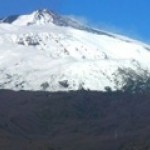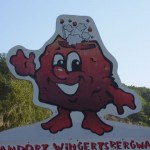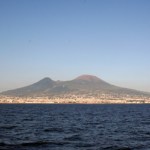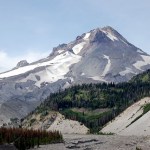Volcano Profile
Etna Week Part 1
Mount Etna - Brief Anatomy of an Exceptional Volcano
By guest blogger Dr. Boris Behncke.
Italy truly deserves to be called "the Cradle of Volcanology" - not only because it hosts virtually all existing types of volcanoes and volcanic rock compositions, and seven of its volcanoes have had confirmed eruptions during the historical period (i.e. the past approximately 2700 years), but also because the earliest surviving eyewitness account of an eruption was written in Italy, the first volcano observatory and the first geothermal power plant were built in Italy, and three…
Cast your ballot for the next Volcano Profile!
Which volcano should be the next Volcano Profile?opinion
The latest in my Volcano Profiles series, this one on Erta Ale in Ethiopia.
The summit crater at Erta Ale in 1994
Location: The Afar region of Ethiopia.
Height: 613 m / 2,011 feet
Tectonic setting: Erta Ale (meaning "smoking mountain") is part of the East African Rift, where the African Continent is tearing apart along a seam that runs from the Red Sea/Gulf of Aden (two other arms of the rift themselves) south through eastern Africa. Many of the large lakes of eastern Africa such as Lakes Albert, Tanganyika, Nyasa and Kariba fill rift valleys created by the cracking of the continental plate…
We've been discussing calderas recently on Eruptions (I wonder why) and the Laacher See in Germany came up. I've actually been to the Laacher See on a field trip lead by one of the world's experts on the caldera, Dr. Gerhard Worner. So, I thought I'd post some pictures and talk a little about this feature that up until maybe 5 years ago, I didn't even know existed.
Laacher See, Germany
The Laacher See is a caldera in the Rhine Valley of Germany (see below). It is only ~30 km south of Bonn and ~60 km south of Koln (Cologne), just to the west of the Rhine River. It is part of the East Eiffel…
Some brief notes before I dive headlong into the exciting world of faculty orientation!
A small steam plume coming from Turrialba in Costa Rica. Photo taken in August 2007.
There are some preliminary reports of the state of wildlife (and everything) around Kasatochi Island in the Aleutians from the US F&W and USGS team that headed to check out how the island has recovered since last year's eruption. The shoreline has been radically transformed by the ash and although some seabirds have made attempts to nest in the loose ash, it doesn't seem to have been very successful. However, not…
Time to vote for the next Volcano Profile. Feel free to leave any comments or suggestions after answering the poll!
What should be the next volcano for the "Volcano Profile" series?(surveys)
The next up in my Volcano Profiles Series, is one of the most remote volcanoes on the planet, yet also one of the more closely studied and monitored (albeit from afar). Joining Vesuvius, Hood and Rabaul is Mt. Erebus, an active volcano on Ross Island in Antarctica and it definitely has some unique features.
VOLCANO PROFILE: MT. EREBUS
Mt. Erebus in Antarctica with a local resident in the foreground.
Location: Antarctica* (technically, it is on the part of Antarctica claimed by New Zealand, but the Antarctic Treaty System more or less makes the continent an international zone.)
Height: 3,794…
Some volcano news before the weekend:
The Barujari vent at Mt. Rinjani erupting in May 2009.
Barujari, the small basaltic volcano located in the crater at Mt. Rinjani, is "spewing 200-meter-high lava", at least according to recent reports. It is unclear if the eruption is, in fact, a fountain or merely strombolian activity throwing incandescent blocks that high (see above). My guess is that it is the latter, as that is much more typical for Barujari. Another report mentions a 600 meter "river of lava" (in spanish) that ends at Segara Anak lake. The volcano has been erupting all spring with…
Now that we've had three Volcano Profiles: Rabaul, Hood and Vesuvius, now it is time to vote on the next volcano. Take your pick and leave comments!
What volcano should be featured as the next "Volcano Profile"?(polling)
The latest in my Volcano Profiles Series, we turn to Europe and Vesuvius. You could fill many, many volumes with the works produced on Vesuvius since Roman times. This profile will barely scratch the surface when it comes to the vast geologic and human history surrounding the volcano, but it is a start. If you want to learn more about the archaeology surrounding Vesuvius, try visiting Blogging Pompeii.
VOLCANO PROFILE: MT. VESUVIUS
Mt. Vesuvius in Italy. Image courtesy of Dario Leone.
Location: Italy
Height: 1,281 m / 4,203 ft
Geophysical location: The tectonics in the Mediterranean are…
Things were relatively quiet, volcanically speaking, over the weekend and that reminded me, it is just about time to vote on the next in my Volcano Profile series. We've had two volcanoes featured so far: Rabaul in Papua New Guinea and Hood in Oregon. Take a look at the list below and vote for the next in the series!
What would you like to see as the next "Volcano Profile"?(opinion polls)
Back in the days when Eruptions was on Wordpress, I held a vote about what volcano should be the next to be profiled on this blog. The winner was Mt. Hood in Oregon, and after much waiting, the profile is here. I will actually be out of town until Monday doing some house shopping in this little town. Enjoy this look at one of the most picturesque (and hazardous - #4 in fact) volcanoes in the lower 48 states.
VOLCANO PROFILE: MT. HOOD
Mt. Hood, Oregon in August 2008 taken by Erik Klemetti.
Location: Oregon, U.S.A.
Height: 3,426 m / 11,240 ft
Geophysical location: Along the Cascade arc where…
Sorry about the dearth of posts. It has been a busy week here in Davis and I've been a little distracted by the upcoming election. Combined with the relative lack of volcano news this week, the posting has been lackluster.
However, that being said, I will try to make up for some of it by starting my Volcano Profiles series that will bide the time between volcano news. I start with a volcano that was suggested by Eruptions reader Thomas Donlon: Rabaul.
VOLCANO PROFILE: RABAUL
Â
Location:Â Papau New Guinea
Height: 688 m
Geophysical location:Â Boundary…



